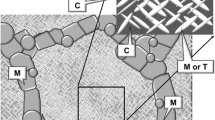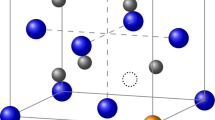Abstract
The kinetics of the oxygen exchange reactions at the electrodes of a galvanic cell using yttria-doped zirconia single crystals (9.5 mole-% Y2O3) as solid electrolyte and Pt or Ag as electrode materials was studied by complex impedance spectroscopy. The electrode resistance when using silver was found to have negligible values over the temperature range 180 – 900 °C. In agreement with these results, oxygen sensors were tested successfully at temperatures as low as 200 °C. According to the performance of silver as electrode material, an electrochemical method was developed to determine the oxygen diffusion coefficient in doped zirconia. The results obtained, compared to those of conductivity and oxygen tracer diffusion measurements, have allowed us to obtain information both on the structure of the defects in yttria-doped zirconia and on the correlation factor.
Similar content being viewed by others
7. References
T. Inoue, N. Seki, K. Eguchi, H. Arai, Low-temperature operation of solid electrolyte oxygen sensors using perovskite-type electrodes, J. Electrochem. Soc.137, 2523 (1990).
S.P.S. Badwal, M.J. Bannister, W.G. Garrett, Low-temperature behavior of ZrO2 oxygen sensors, Science and Technology of zirconia, Advances in Ceramics 598 (1984).
S.P.S. Badwall, New electrode material for low temperature oxygen sensors, J. Electroanal. Chem.146, 425 (1983).
T. Ishihara, T. Kudo, H. Matsuda, Y. Takita, Doped perovskite, PrMnO3, as a new cathode for solid-oxide fuel cells that decreases the operating temperature, J. Am. Cer. Soc.77, 1682 (1994).
B.C.H. Steele, J. Drennan, R.K. Slotwinski, N. Bonanos, E.P. Butler, Factors influencing the performance of zirconia-based oxygen monitors, Science and Technology of zirconia, Advances in Ceramics3, 296 (1981).
N.Q. Minh, Ceramic fuel cells, J. Am. Cer. Soc.76, 563 (1993).
J. Ross Macdonald, Impedance Spectroscopy, John Wiley (1987).
W. Weppner, R.A. Huggins, Electrochemical method for determining kinetic properties of solids, Annual Review Material Science8, 269 (1978).
M. Filal, C. Petot, M. Mokchah, C. Chateau, J.L. Charpentier, Ionic conductivity of yttrium-doped zirconia and the composite effect, Solid State Ionics80, 27 (1995).
H. Solmon, J. Chaumont, C. Dolin, C. Monty, Zr, Y and O self-diffusion in yttrium-doped zirconia, Ceramic Transactions, The American Ceramic Society24, 175 (1992).
H. Yanagida, R.J. Brook, F.A. Kröger, Direct current-voltage characteristics of calcia-stabilized zirconia with porous platinum electrodes, J. Am. Cer. Soc.117, 593 (1970).
J. Xue, R. Dieckmann, Non-stoichiometry and point defects in zirconia, Ceramic Transactions, The American Ceramic Society24, 49 (1991).
W. Weppner, Electrochemical Transient Investigations of the diffusion and concentration of electrons in yttria stabilized zirconia-solid electrolyte, Z. Naturforsch.31a 1336 (1976).
W. Weppner, Electronic transport properties and electrically induced p-n junction in ZrO2+ 10m/0 Y2O3, J. Solid State Chemistry20, 305 (1977).
K. Hauffe, Gas-solid reactions — oxidation, Treatise on Solid State Chemistry (B. Hannay, ed.), Plenum Press, New York4, 389 (1976).
P. Kofstad, Nonstoichiometry, Diffusion and Electrical Conductivity in Binary Metal Oxides, Wiley Interscience, New York (1972).
H. Schmalzried, Transport theory of oxide electrolytes, Science and Technology of Zirconia, Adv. in Ceramics, The Amer. Cer. Soc.3 254 (1981).
G. Petot-Ervas, C. Petot (to be published).
J. Philibert, Atom Movements Diffusion and Mass Transport in Solids, Les Editions de Physique (1991).
H. Rickert, General aspects of solid electrolytes, Fast Ion Transport in Solids (W. van Gool, ed.) North Holland Publishing Company, New York3 (1973).
C. Wagner, “The thermoelectric power of cells with ionic compounds involving ionic and electronic conduction”, Progress in Solid State Chemistry7,1 (1972).
Author information
Authors and Affiliations
Rights and permissions
About this article
Cite this article
Petot-Ervas, G., Rizea, A. & Petot, C. Electrode materials, interface processes and transport properties of yttria-doped zirconia. Ionics 3, 405–411 (1997). https://doi.org/10.1007/BF02375717
Received:
Accepted:
Issue Date:
DOI: https://doi.org/10.1007/BF02375717




